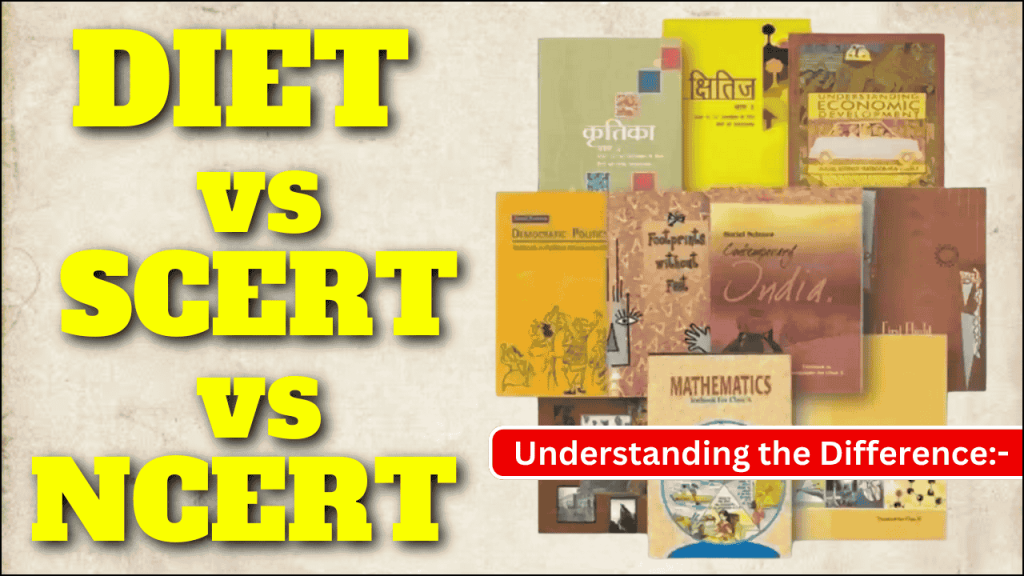
In today’s world, education is important for survival and India has made a specific organization that will help in maintaining the quality of education. These organizations are DIET, SCERT, and NCERT. Now, you will be thinking of what the purpose of making these three organizations is and what these organizations will do for the better future of children. All these details will be covered in the next part of this article.
What is DIET (District Institute of Education and Training)?
DIET stands for District Institute of Education and Training. It is a government-run institution established in every district of India. DIET’s main objective is to provide training to primary and upper primary school teachers and ensure quality education at the grassroots level by implementing teacher training programs.
Functions of DIET:
- Conducts pre-service and in-service training programs for teachers.
- Develops teaching-learning materials for primary and upper primary education.
- Provides academic support to schools in rural and urban areas.
- Implements government education policies at the district level.
- Researches educational problems in schools.
- Organizes workshops and seminars for teachers.
- Trains headmasters and school administrators.
Structure of DIET:
DIET is structured into different branches to handle various educational activities. Some of the key branches include:
| Branch | Function |
|---|---|
| Pre-Service Teacher Education (PSTE) | Trains future teachers through diploma courses. |
| In-Service Program Field Interaction (IFIC) | Provides refresher courses and workshops for working teachers. |
| District Resource Unit (DRU) | Supports non-formal and adult education programs. |
| Educational Technology (ET) | Integrates technology in teaching. |
| Curriculum, Material Development, and Evaluation (CMDE) | Develops study materials for schools. |
| Planning and Management (PM) | Assists in the implementation of education policies. |
What is SCERT (State Council of Educational Research and Training)?
SCERT stands for the State Council of Educational Research and Training. It is a state-level body responsible for educational planning, curriculum development, and teacher training. SCERT operates under the guidance of NCERT and tailors educational programs to meet a state’s specific needs.
Functions of SCERT:
- Designs the school curriculum and textbooks for state schools.
- Conducts teacher training programs at the state level.
- Prepares study materials and teaching aids.
- Implements national education policies at the state level.
- Researchers state specific educational issues.
- Monitors the performance of DIETs and provides guidance.
- Collaborates with NCERT to develop national curriculum frameworks.
SCERT’s Role in Teacher Training:
SCERT plays an important role in training teachers and educational professionals. It provides:
- Orientation programs for newly recruited teachers.
- Refresher courses to update teachers with the latest teaching methodologies.
- Training on the use of technology in classrooms.
- Special training for teachers handling inclusive education.
Difference Between DIET and SCERT:
| Feature | DIET | SCERT |
| Level of Operation | District | State |
| Main Focus | Teacher training and school support | Curriculum development and educational research |
| Scope | Works within a district | Covers the entire state |
| Under the state government, linked with the NCERT | Under SCERT | Under the state government, linked with the NCERT |
| Under the state government, linked with the NCERT | Training teachers in a district | Designing textbooks, training teachers, and monitoring DIETs |
What is NCERT (National Council of Educational Research and Training)?
NCERT stands for National Council of Educational Research and Training. It is an autonomous organization under the Ministry of Education, Government of India. NCERT is responsible for designing school curriculum, preparing textbooks, and conducting educational research at the national level.
Functions of NCERT:
- Develops the National Curriculum Framework (NCF).
- Designs and publishes school textbooks for CBSE and other boards.
- Conducts research in the field of education.
- Provides training to teachers and educational administrators.
- Assists the government in policy formulation.
- Develops digital learning materials and online resources.
- Promotes innovative teaching methods and strategies.
NCERT Textbooks:
NCERT textbooks are widely used in schools affiliated with the Central Board of Secondary Education (CBSE). Many state boards also adopt NCERT books or follow their guidelines.
Difference Between SCERT and NCERT:
| Feature | SCERT | NCERT |
| Level of Operation | State | National |
| Main Focus | State curriculum and teacher training | National curriculum and research |
| Affiliation | Linked with state government | Autonomous under the Ministry of Education |
| Linked with the state government | Prepares state-level syllabus and books | Develops national-level curriculum and books |
Key Differences Between DIET, SCERT, and NCERT:
| Feature | DIET | SCERT | NCERT |
| Level | District | State | National |
| Focus | Teacher training | Curriculum and teacher education | Curriculum, research, and policy-making |
| Scope | Covers district-level education | Covers state-level education | Covers national education policies and curriculum |
| Works Under | SCERT and State Education Department | State Government | Ministry of Education, Government of India |
| Key Responsibility | Provides training to district teachers | Develops state curriculum, trains teachers | Develops national curriculum, conducts research |
Key Takeaways
DIET, SCERT, and NCERT are made to improve the quality of education in India. DIET organization is built to look at education at the district level, SCERT organization is built to look at education at the state level, and NCERT organization is built to look at education at the national level.









